The City of Oaxaca reflects the mix of indigenous heritage and colonial architecture, houses of no more than two stories high, which in most cases are painted pastel colors. Also known as the "Green City", because many of the quarry that gives life to the buildings is this color. Such is its architectural splendor for which he was designated a UNESCO World Heritage Site. In the center of the city is the Zocalo, consisting of two squares. It is a place where you can spend hours and hours just sitting on a bench, or on the terrace of a bar, watching the comings and goings of people: there is always animated. Craft vendors, children playing, the shoeshine boy who is always aware of everything going on, or simply admire the colorful costumes of some folk can get the delight of our eyes. At night, the Zócalo is enlivened still more. Listening to the state band, rock bands, or the occasional mariachi, our dinner will be even more Mexican flavors.
Archaeological Site of Monte Alban. Wonders of the year 500 A. C. placed at our feet. It is located 9 miles west of the City, is an important rectangular plateau, which sits one of the greatest archeological sites in Mexico, built during different periods by the Olmec, Zapotec and Mixtec. Specifically is the largest city of the Zapotec (fourth largest indigenous group in the country). They realized they needed to defend themselves against invaders. Looked for a place to observe three divisions of the valley as a whole as well as two rivers, the Rio Salado Atoyac. These rivers flowed parallel to the major trade routes. With the construction of a pyramid at this site was possible to control the Valley of Oaxaca. If we scale Monte Alban in the morning you can see the morning mist, it lingers over the valley like a veil night and rises when the sun rises. Perhaps this is why the Zapotecs used to call themselves "people of the clouds."
Monte Alban civilization existed in the year 500 BC C. In 1500 D. C. In its cultural peak the city had 25,000 residents. The elite lived in palaces on the mountain plateaus. The mountain was densely populated and was divided into terraces with houses and fields of corn. It was an important ceremonial center, among its most outstanding buildings include: the Building of the Dancers, the Ball Court and the Observatory, and a series of sculptures carved in high relief. Currently working on the reconstruction of some architectural pieces seriously hit by the severe over time.
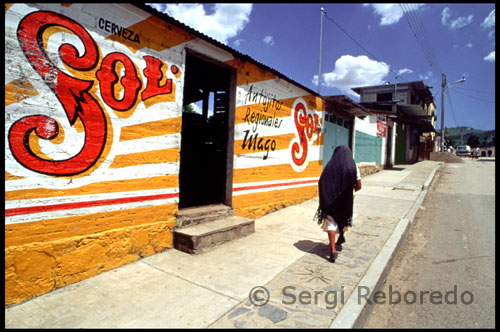
Archaeological site of Mitla. The Mitla environment differs greatly from that of Monte Alban with its magnificent views, however, the architecture of Mitla is impressive. Is about 45 km east of the city, its name means "Place of the Dead" and its construction dates from about the year 800 A. C. Is another important archaeological site built by the Mixtec-Zapotec culture. Its plan is cruciform architecture and its chambers and antechambers are richly decorated with carved friezes asambles and fretwork in the style of the facades of the main buildings. Is much smaller than Monte Alban, but the decorations of the palaces are amazing. The archaeological zone is divided into two parts, and to see one of them must pass through a Catholic church. You can access several tombs. The number 1 is a monolithic column supporting the roof, which is called "Column of Life", and is said to embracing, for the remaining distance between the fingertips, you'll know how many years you live . 2 presents the Tomb mural on stucco in its interior lintels. The tradition was the burial funeral row, depositing the corpses with their offerings to the sides and removing the remains of earlier deposits. Both tombs were explored between 1900 and 1902 by Mushall Saville, although they had been looted in earlier times.
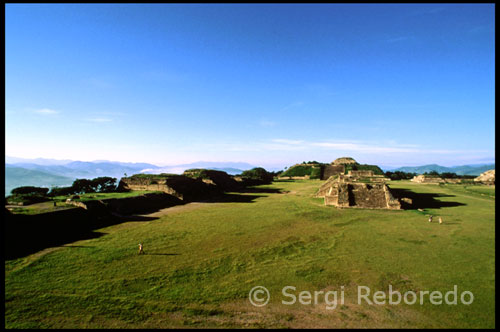
Yagul Archaeological Zone. This area is one of the greatest baseball games of the Oaxaca region. It's eight o'clock in the morning, and after 36 km, the bus driver tells me that we have reached the height of Yagul. We got two people, and in front of us only could see a long straight road with lots of greenery on both sides. The archaeological zone is about 2 km from the junction of the Oaxaca-Mitla, and Ernesto was also directed there. He works eight hours on a national conservation plan restoration. A few days clean, other days the abundant short grass growing nearby, and specifically today decant sand. It's similar to what once were gold miners. A truck brings sand, and he, through a sieve, separating the tiny stones by size, to achieve the maximum possible, similar to the thickness of a coffee bean. These, then, mixed with a cement, compacted the spaces between the stones of the buildings Zapotecs, in order to help her stay in time. This area was settled in 700 B.C. until the year 1512 AD, its name comes from the Zapotec word meaning YA-Gule "OLD TREE OR STICK," its main structures are: ball game, all the seven courtyards, temple, fort, tombs, plazas, and areas housing. The location of Yagul was of great military importance, as it is located on a mountain overlooking the Valley of Tlacolula visually and this allowed it to be easily defended from enemy groups.
San Bartolo Coyotepec. The largest pottery center of the state, or just a good place to play volleyball street. San Bartolo is a small town located 15 km south of Oaxaca City. His reputation is recognized internationally for the originality of his pieces in black colored clay. This finish is achieved by a process secret, kept from father to son, applied for firing pottery. It also has a craft market, in which the creators of art will be responsible to teach and sell their works. Once the market visit, I thought I'd have to go beyond what my eyes were seeing: see what it was really the common people, where they lived, what they did, or simply spent what free time. I started walking along the dusty unpaved streets. The houses, built of stone and one level in most cases, hiding in backyards that exploited the space to let the clay dry in the morning. Firewood stacked next to the big oven, the children running after the chickens, a couple of horses tied to a tree, all was harmony and simplicity. Far away from the street where I was, I could see some kids playing. At first it was presupposed that a game of street football, but little by little, as I approached I began to see the network, and I realized it was a game of volleyball street. The network, tied across from house to house, divided the kids into two teams. The sandy soil, with occasional puddle, and t-shirts over a muddy, did assume that the party was serious. Little by little, I was integrated into the sports environment that is breathed there. If in Spain the most popular sport is football, there it is volleyball. It was a three-set match and the losers would have to pay the beers. It was not sporadic, commented, "Every evening we meet to take the match." I had already guessed, the quality of play, but was not professional, denoting a certain set. For over an hour I was taking snapshots, until Claudio took a pass near the net, changed the game to the opposite side, and Alfonso was coming from behind crushed. Full time, had won two sets to one, and now it was cool and mitigate the heat. I was invited to the party as it was the only reporter who had all the time who had playing volleyball, and headed to what they called bar. It was a ground floor, which belonged to Louis, one of the players of the losing team. A room of no more than 30 square meters, which only had a fridge and a plastic table with seven or eight chairs was enough to chat and play a few games at cards, when the weather prevented them from playing volleyball. On the wall hung two posters, one of a half-naked American actress and one of a surfer on the beach in Puerto Escondido. Light, placed so that illuminated the table, was a bare bulb, supported by the cable that kept her alive. Once answered the barrage of questions about Spain, I decided it was time to find out what they actually did when they were playing volleyball. Less Ernesto, who helped his father in the field, all others revolved around the black mud. Almost every family had a bake oven where the mud, and some even boasted of having created molds with their own designs. Others simply worked every day in small stores that were scattered near the town hall selling the mud that had been prepared the day before his brothers. It's a tough business, working seven days a week, and there is rarely vacation. The only relief the day, I said Claudio, "is expected to arrive at six in the evening, no rain, and play our game of volleyball."
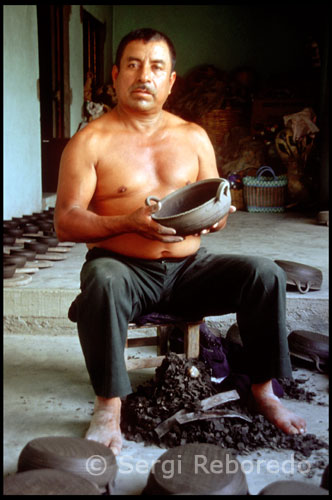
Santa Maria Atzompa. If San Bartolo Coyotepec known for his works in black mud, Santa Maria Atzompa do it for the development of green glazed pieces and natural clay. First the clay is baked, and then is given the green dye. Stand out above all the huge pots made with the technique of appliqué and openwork. Joaquin Juarez is one of the local craftsmen. When I got home, his wife was wrapping the vases that were dry and ready to be sold. Meanwhile, he barks others to leave them smooth and polished. At first, when the clay is still soft, are of a darker hue, such as Coyotepec, but then the mud takes its color, letting us know that you are ready to be painted green. Atzompa ceramics are usually for domestic use, especially pots abound, such as that shown in the photo Joaquin. When sales do not work, or the number of parts produced is excessive mud, pots give way to what they call "dolls embroidered." They are figures of clay, handmade, without any molds, and are often inspired by silhouettes of animals or dolls. The location of the village is ideal for sales, as it is situated at the foot of Monte Alban, only 6 km from the city of Oaxaca. Despite its home market in the population, always get better sales in most tourist places: if the mountain will not come to Mohammed, Mohammed will go to the mountain. During the morning is when fired ovens, and you can see black smoke coming out of the houses even several kilometers. All the people engaged in the same, but there is no spirit of rivalry, but quite the opposite. Joaquin said: "We are all primarily friends. When my neighbor sick, my wife and I miss him a hand. Any day can happen to me, and is a pass to keep surviving." His wife is coming with photos in hand very old, black and white: "These are my parents. Look, were boiling mud. We have inherited generation after generation, do not really know anything else. This is what we makes it different from other people. " Admittedly, the work itself requires skill, especially animals, made in a kind of mud that they call frosting. All different, all works of art.
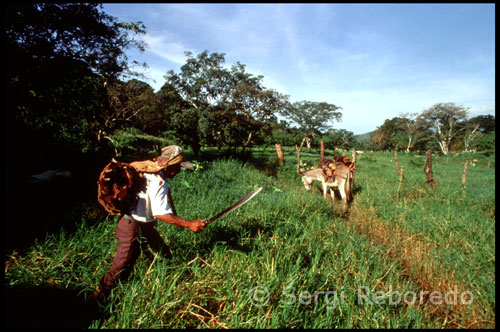
Zaachila. It is located 17 km southeast of Oaxaca City, and what's different about this town is his personal market. It is open on Thursdays and, instead of the typical crafts, sell all that there is firewood. Larger pieces of wood, smaller, higher quality, lower quality, cut, uncut ... Everything revolves around the wood. Some arrive in trucks loaded to capacity. Others in 4 X 4 and less charged with her graceful shoulders. The main street is a parade, people coming and going to market. A horse pulls a huge empty car. Soon becomes exhausted with the car packed. It is the only state firewood market. Wood is needed to keep alive Coyotepec ovens, the Atzompa, and many other peoples who are in the business of the mud. It is getting dark and it rained. The soil water reflects the colors of the city. The town is located in a very lush and as we move into the nucleus the green gives way to the bright colors that are painted on the facades of houses and shops. Here the beauty of things, as so often, lies in its simplicity. No archaeological sites and beautiful beaches where diving, but the simplicity of the people and the marked rural-colonial air of the people get a mix that makes everything different. Everything you go through the eye. You could spend hours just sitting watching the car going, the truck coming, children playing, or the elderly who do not agree on the price you want to make him pay for the bundle of firewood.
Ayutla. Where ends the logical and the uncertainty begins. It is located over an hour and a half of Mitla, along a winding, sandy, full of potholes, which boasts the driver know the way well, accelerating all that lets the engine. Meanwhile, the passenger suffered, new to me, says everything he knows to the next bend suddenly appears not another bus. That morning I had to get up early, there were 3 hour bus ride from Oaxaca, but the worst was the combination to get. A bus would take me to Mitla, and there had to wait for another to pass Ayutla. The reason for my visit was to meet the people of the mountains, a culture that retains its native roots (some could not even speak Castilian). The bus soon, it was different from the rest, or at least the inside. Boxes of fruit, other vegetables, a pig in a sack, the peep-peep of some chickens, everything is stacked with people who had almost no place to go sit. It was like Noah's ark. The passengers, people came to the city, was to buy supplies for at least a week. Once there, I started making the visit of rigor to the pastor. There were two reasons: the view from the towers are often the best, and they are the ones who know everything about people. The cleric was on a ladder, changing the glass of a window, and while I could not speak much with him, gave me permission to climb the bell tower. After panning, I decided to relate a little with people. They were friendly, though a bit reluctant to my camera. Me at all times speak Castilian, but when having a conversation between them did so in another language. You can still see some people in the mountains, apart from the rest of civilization, the ancient cultures, with all that that entails: language, dress, illusions, habits ...
How long will affect globalization?.
The small fruit stands exposed in the main square. Other people from remote villages, Ayutla used as intermediate market for shopping, and not have to waste a whole day going to the capital. Ayutla, is the border between civilization and indigenous culture.
Boil Water. It consists of two cascades of petrified calcium carbonate, and two pools of carbonated water, giving a false impression that the water is boiling. Hence the name: Boil Water. It is situated south of Mitla, where they leave in an hour vans come here. The water flows above ground, or out of the rocks, to keep always full of "pools". Due to its composition, calcium carbonate, gives the impression that you are immersed in a huge jacuzzi. The Oaxacan territory is populated water sites, some are characterized by sulphurous waters (cold or hot), others for its hot springs, limestone water, or carbonated water, as is the case of Boil Water. Oaxacans are aware that they have a divine treasure, and enjoy some holidays by contacting nature. Bathing in the pools can be shared with a two-hour ride down the mountain. There is a well marked path, he discovers the most intrinsic. The area has a small resort, which far from making competitive nature intended approach to certain amenities: there are cabins to spend the night restaurants to satisfy hunger, coconut vendors, and last but not least two pools, although they are artificial. We can spend an entire day participating and enjoying one of the most beautiful in the country, with the advantage that its location is very accessible. Others, however, have been ignored because of their inaccessibility, or by their remoteness. While the tourist does not usually come to these places, you should visit, especially during the week that is less crowded and enjoy more. To return, the latest vans out on the six-thirty.
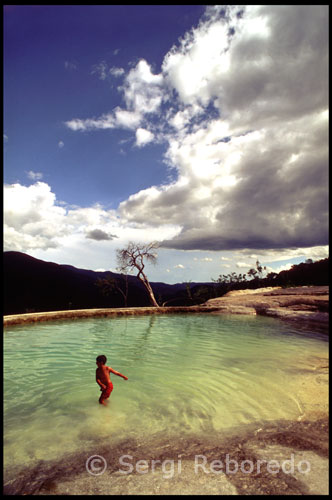
Text and photos: Sergi Reboredo.
The Oaxacan Coast is paradise for everyone, from fishing in crystal clear green water, surfing with waves up to 8 m, contemplating the hidden beauties dive under water, to drink up a coconut on a deserted beach. By Sergi Reboredo.
Puerto Escondido. Above all it is a fishing village, but is increasingly favored by domestic and international tourism. In the sea of the main beach the boats come and go selling the fish so far. Fifty meters from the beach and parallel to it, is a walk where there are shops of all kinds. We can buy souvenirs, money exchange, taste the typical food of the area to fresh fish, or even if your stomach is very packed with spicy, eat international fare. The main coastal road separates very clearly the fishing-tourist area of the town center. Once across this highway hotels give way to the stone houses where the locals live. The main street, one of the few that are paved, arrives at the Benito Juarez Market, selling the delights of the sea (caught that morning) and fruits and spices.
Walking along the main beach you can reach the jetty. There, children are engaged in fishing. The system is quite curious. A nylon thread, with a tiny float on top, is released as if it were a grave not many yards from shore. A few inches of the buoy, a hook with a piece of sardine. When hundreds of smaller fish are attacked by larger ones rise to the surface breaking the tranquility of the water. At that time, take the opportunity to deal a blow dry straight, to himself. Some fish to see the movement of sardines are attracted to bite and sting. Others, less agile, they can not dodge the hook that comes towards them at high speed and just hooked in any part of your body.
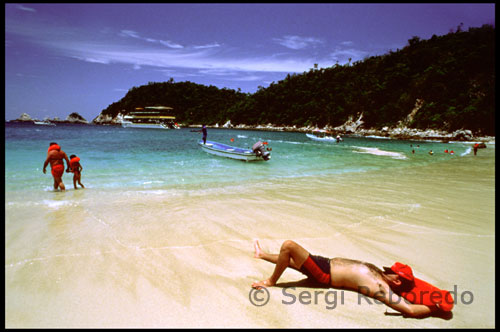
The next morning, before the sun begun to appear collected dozens of boats and pull their nets tirelessly, while some birds dive down to get his breakfast. A slight breeze carries water to quickly turn your steering a boat over there, then subtly falls on the network where there has been movement. The sun is already out and slowly following the boats will fish offshore, to re-let the still water, still, reflecting the first rays. Will soon return to the bank, to sell their catch, to the astonishment of the first swimmers, while fisherman discuss buyer and the price of gold, beautiful and occasional tuna.
Zicatela. If the Beach Boys had been Mexicans, they would live in a hut Zicatela. The name comes from the rocky outcrop where the beach ends, though, Zicatela, everyone knows this mixture for several miles in a straight line of sand, with huge waves. The water is clear blue, faded only by the white foam that comes with the waves. These, of type "curl" in some cases reach up to eight meters high, making it ideal for surfing. According to experts of the sport Zicatela is the third best surfing beach in the world, competing even two championships each year, one in August and another in November.
At any time of day there are people practicing surfing, but really it's in their blood tend to be people early riser, and no more early morning and are "waiting for the wave." On the beach, there are log cabins in which to sleep, and prices are not very high. It is pleasant, especially at sunset, walking along the sand, from the Bay of Puerto Escondido to Main Beach Zicatela. During the walking tour, which is not very long, several girls convince us to buy some donuts and homemade cakes GONE honey or a glass filled to the brim with fruit already peeled.
Surfers come out of the water and the boats return to shore, are unmistakable signs that it's getting dark, and night must come to make way for another day. When the moon is reflected in the water and stomachs are satisfied it is time to make way for the party. Near the huts in the sand, people start to go with beer in hand. As you continue bringing you the sound of the Beach Boys are more dormant. Laughter, people dancing, and occasional daring in the water, a California Zicatela make your style. The party has begun will not end soon and too late, tomorrow will be good days and you have to get up early, do not expect waves.
Puerto Angel. Who travel here do to spend at least one or two weeks. It is located about 75 kilometers from Puerto Escondido, almost entirely inhabited by fishermen. It has two quiet beaches: Pier and the Pantheon. It is a quiet place to settle down, the room prices are quite affordable, and being a more or less central location is ideal for visiting nearby sites: Bays of Huatulco, Zipolite, Window and the Butterfly. Not far from the pier, and on the white sand beach, several boys competed a football game. It is shown that boredom does not exist in Puerto Angel, the beaches are not designed just for sunbathing, but it also should enjoy them.
Just 4 kilometers from Puerto Escondido is Zipolite, a one kilometer long beach huts packed for the night, whether housed inside or lying in a hammock placid. This is one of the few that find nude beaches throughout Mexico, and is often frequented by American tourists. The environment differs greatly from the rest of beaches, the party is guaranteed and extends until late at night, so that people start the day at the beach no later than noon.
Bays of Huatulco. The leaflets advertising their strong emphasis on upscale resorts: green golf courses, top party clubs ... but I think they forgot to highlight the most important bays.
Nine beautiful bays that hide each a personal appeal, although they all share the greenery and clear waters. Santa Cruz Bay, but no less beautiful, is the busiest. To access the rest of bays you must rent a boat or join one of the sightseeing cruises leaving the port of Santa Cruz itself, because of their intricate land access situation is impossible. At the port we find catamarans that take us to visit the other bays. One is "My Love". Set sail on the eleven. The sea is calm, quite the opposite of the deck. Clubbing songs follow one after another, and animators constantly dance by involving all passengers.
When the sun heats a great time is the time to cool off. Drinks on board are free. You can start with a cold margarita and make way for a reposado mezcal.
It takes more than two hours to land in the first bay: Riscalillo. Its calm waters are light green and have a large marine ecosystem so they are ideal for swimming and diving.
People are divided into two groups. Some choose to relax on the beach while others opt for diving. I do not even have to worry about the team. This is shared by members of the crew along with a striking red vest. The second stop, and at noon, is more relaxing. The Bay of St. Augustine has several restaurants on the beach to feed the hungry, and its waters are also green and transparent. After eating and relaxing becomes a board to hit the trail back. The day of seaside holidays is over.
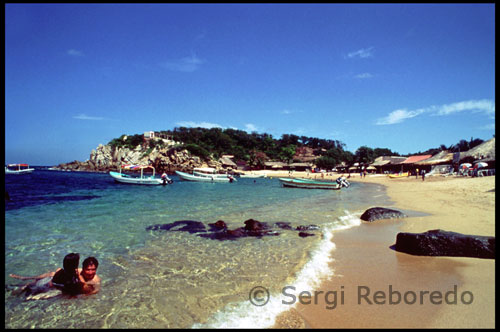
The Oaxacan coast.
Geography
The state of Oaxaca, is located southeast of Mexico, bounded on the north by Veracruz and Puebla, east of Chiapas, Guerrero to the west, and south by the Pacific Ocean.
The city is home to some 250,000 people, and other 3,000,000 inhabitants are scattered throughout the state.
Directions
The two main sites, Puerto Escondido and Huatulco, have airport. We can access it directly from Mexico City, or from Oaxaca. If our economy does not allow this, the bus from Oaxaca only cost us 100 to 150 pesos, depending on the category of the bus. If the destination is Puerto Angel, we must bear in mind that the "truck" a people before we leave, Pochutla, from there, by just over 5 dollars a shared taxi will bring us closer to the destination.
Currency
The official currency is the peso. Another option may be the traveler's checks, which will give extra security to our money, and are accepted in all banks and exchange offices. You can also make purchases or withdraw cash with credit cards Visa and Mastercard.
Clothing
Always light clothing that can be easily washed and dried, sneakers, bathing suit, towel, sandals, good sunglasses and golf equipment, if we intend to dive. While this equipment can be rented us no problems there, always more comfortable lead ours. Do not forget that it takes for some afternoon rain, a raincoat and folding we can pull through.
Corners very tempting
1 - Puerto Escondido
Village located at 310 km south of Oaxaca, where fishing is interspersed with local tourism. It is convenient to shop around the local market of alabaster. The sunsets are magnificent, and slightly rising early, we were fascinated to see how the boats fishing a few meters from the shore, while dawn.
2 - Zicatela
It is truly a beach surfer: open sea, long, and huge waves that sometimes reach eight feet. Each year there are two professional surf championships, and as understood is the third best beach in the world for this sport
3 - Puerto Angel
Located east of Puerto Escondido is this quiet fishing port.
Suitable both for those looking for relaxation on your vacation and for those looking for a spot to settle and explore the surrounding areas.
4 - Bays of Huatulco
Upscale resorts give way to nine beautiful bays of land access impossible. From the port of Santa Cruz can rent boats or go on excursions on board catamarans. All bays are characterized by greenery and clear waters, this being ideal for scuba diving.
Boil Water, a natural paradise where travelers can relax from the stress of the city plunging into a deep natural pools of turquoise green, enjoy the views offered by cascades of salt and even taste the delicious cuisine of Oaxaca.
Boil water in many geologists, biologists and archaeologists who have studied the ground. The area has been recognized as a likely site of the ancient Zapotec sacred and is around an irrigation system that can be dated back over 2500 years and which currently artifacts remain.
The Oaxacan territory is populated water sites, some are characterized by sulphurous waters (cold or hot), others for its hot springs, limestone water, or carbonated water, as is the case of Boil Water. Oaxacans are aware that they have a divine treasure, and enjoy some holidays by contacting nature.
Sparkling water pools where you can relax.
Although his name at first seems to indicate that it is very hot thermal waters, actually there are several warm springs springs not that because of its effervescence gives the impression that they are about to boil. Water temperature is slightly higher than that of the environment and about 22 º C - 25 ° C, far from 100 ° C it would take for the water to begin to boil.
The water temperature is perfect, not too cold or too hot. From there you can see how the clouds draw strange shapes on a dark blue sky trying to touch the tops of the mountains nearby. Everything is peaceful and quiet, romantic and sensitive. Maybe it's the closest thing to paradise that everyone dreams to be someday.
The water flows above ground, or out of the rocks, to keep always full rafts. Due to its composition, calcium carbonate, gives the impression that you are immersed in a huge jacuzzi.
When you reach the center stay impressed raft, water is a turquoise green color identical to that found on the beaches of any island in the Caribbean Sea.
Bathing in the pools can be shared with a two-hour ride down the mountain as there is a well marked path to discover the most intrinsic.
Salt petrified waterfalls.
The petrified waterfalls can be seen from the bottom of the mountain. Form stalagmites, which are similar to those found in internal caves, because it produces a continuous drip ring calcite and travertine. It is as if time had stopped and the water had turned to stone.
The salt water stalactites hang down from the heights around the world and usually referred to as "Waterfalls of salt." Its formation dates back thousands of years and is one of the most unusual of all planetary geography.
Not far from the waterfall several vendors are struggling to sell their freshly made quesadillas to tourists, who after a day so intense hunger begins to pass the bill.
There is now a small area in the resort, which far from making competence to the nature, aims to bring some comfort to tourists: there are cabins to spend the night eateries to satisfy hunger, and bathrooms. If you do not intend to spend the night must be taken into account that the last van leaving at 6:30 bound for Mitla.
It is a day of contrasts, relax in the pools, thrill to discover the beauties of the petrified waterfalls, inner peace and, above all, hope, hope for being able to be in a dream paradise.

Boil the water.
Geography
Boil the water cascades are 70 miles southeast of Oaxaca City. The state of Oaxaca, is located southeast of Mexico, bounded on the north by Veracruz and Puebla, east of Chiapas, Guerrero to the west, and south by the Pacific Ocean. The city is home to some 250,000 people, and other 3,000,000 inhabitants are scattered throughout the state.
Getting there
Once in the city of Oaxaca the most practical and economical is to catch a bus at the bus terminal towards Mitla, there change bus in 1 hour and we will come to Boil Water. If you have your own car take Highway 190 to Tehuantepec. Upon arrival we drive to Mitla Ayutla, after 17 km take the turning to Albarradas and 5 km of this town find Boil Water. We can come to Oaxaca by plane, because it has airport (Xoxocotlán), or train.
Small tips
Paperwork
You do not need visa for stays of less than 90 days, but a valid passport, valid for six months.
Climate
In the city of Oaxaca is spring all year round, with temperatures ranging between 16 º C in winter and 25 º C in spring.
Currency
The official currency is the Mexican peso and euro equals about 11 pesos. Another option may be the traveler's checks, which will give extra security to our money, and are accepted in all banks and exchange offices. You can also make purchases or withdraw cash with credit cards Visa and Mastercard.
Clothing
Always light clothing that can be easily washed and dried, sneakers, bathing suit, towel, sandals and good sunglasses. Do not forget that it takes for some afternoon rain, a raincoat and folding we can pull through.
Services
In the vicinity of Boil Water will find bathrooms, changing rooms, and small restaurants where you can satiate your appetite and enjoy the cuisine of Oaxaca. There are also fully equipped cabins where we spend the night.
By Sergio Reboredo (Text and photos)
Beside me sits a stout woman of tanned hands and many springs stuck in the grooves of your eyes. For a long time struggle to close a bag of vegetables inside trying to escape every time the driver turns the steering wheel. It has a penetrating gaze and a commanding voice. His complaints about the rising prices of the fruit are replicated from the back of the bus by the "kikiriqui" of hens struggling to emerge from the cages.
My destination is the waterfalls Boil salted water, a sacred place surrounded by nature, with a couple of pools where you can swim listening to the birdsong. The site is accessible only by road from the town of Mitla in Oaxaca, Mexico.
The Oaxacan territory is populated by water deposits. Some are characterized by sulfurous water (cold or hot), others for its hot springs, limestone water, or carbonated water, as is the case of Boil Water.
Although his name at first seems to indicate that it is very hot thermal waters, actually there are several warm springs which by their excitement, they appear to be at boiling point. Water temperature is slightly higher than that of the environment, ranges between 22 º C and 25 ° C, far from 100 ° C it would take for the water to begin to boil.
Many geologists, biologists and archaeologists who have studied the ground. The area has been recognized as a probable ancient sacred place of the Zapotecs. Nearby is a system of irrigation may date back over 2500 years old, and which currently artifacts remain.
The reason I is not been there to visit remote places of the country or archaeological remains. I just want to rest, relax and let the peace flood my body. But while the distance separating them Mitla is not excessively large, the constant stops make the journey an endless journey.
The bus looks like a real grocery store with all kinds of fruits, vegetables and various farm animals. All the way we face the winding route of the road. The curves are too steep, and all the baggage that is not attached firmly wobbles from side to side, threatening to fall to the ground when you least expect.
I close my eyes and feel like I've come back several centuries in time. The bus has become something akin to Noah's Ark traveling the winding roads that access to the many semi-isolated peoples in the region. The houses are scattered, and the only way to provide food is down from the mountains to Mitla one day a week and buy all the supplies needed.
The bus is slowly getting empty. Now remain only the driver, two families with children (who had also risen in Mitla) and me. The atmosphere is dense, since the entire interior has been imbued with a strong odor, a mixture of jungle and sweaty shirts after a disputed soccer game.
Finally, after a stop in San Lorenzo Albarradas, the bus reaches its destination. From the window he saw the two impressive petrified waterfalls decorated with stalactites, similar to those found in interiors of caves, which form a continuous drip that produces rings of calcite. Suddenly, I feel as if time had stopped, and therefore, the water had turned to stone. I fear that at one time or another all giving life and fall on my head.
Not far from the waterfall I stop to chat with Mary, an old woman who earns her living selling quesadillas to tourists. His head is covered with a handkerchief and his skin bears the scars of time. The business, as I said, it only works on weekends as weekdays are few people who frequent this idyllic landscape. Lives nearby and would not change their place of residence for the world.
Indeed envy. I think in the chaotic traffic of Barcelona in the coming and going of people stressed, and just makes me sick to think that in a few days I should return to Spain.
We eat quesadillas, and tells me that still remembers as a child and his mother came with her to bathe in the pools. Then people came even from the capital, but now it is a contradiction. For one thing people need to come to sell their quesadillas and earn a living, but on the other hand, also like that the area be preserved and not leave deteriorates over time and the abuse of some non love nature.
When I get to the central pool and I expect a lively green turquoise, identical to that found on the beaches of any island in the Caribbean Sea. Several children enjoy a dip in the countryside, while their parents relax peacefully stretched in another pool nearby.
The water flows above ground, or out of the rocks to keep the pools always full. Due to its composition, calcium carbonate, gives the impression that you are immersed in a huge jacuzzi.
It did not take too long to put on my bathing suit and jump to the pond where the two children. The water temperature is perfect, not too cold or too hot. From there I can see how the clouds draw strange shapes on a dark blue sky, trying to touch the tops of the mountains nearby.
I do not want to leave the water, but the wrinkles in the fingertips show that I have already relaxed enough. Now is the time to continue exploring the field. I have time for a two hour ride along the trails of the mountain before returning to Mitla.
There are several well-marked paths that you find the most intrinsic and rugged place where you can contemplate the beauty of the landscape and its surroundings from another point of view. The closest mountains whisper in his ear peace and harmony, and only when you're immersed in them you realize that man is only one particle in a vast ocean of beauty. Nowhere in the world, whether in the highest mountain or the sea farther, you are offered a truth so emphatic as here. If ever there was indeed a paradise, Adam and Eve had to live not far from here.
From the top of a nearby summit look like the latest vans leave for Mitla, and I returned to civilization, begin to fill with people. Back stay calm and relaxation pools, and a tour around I will never forget thanks to a lot of pictures and a recipe on how to prepare the best quesadillas, the best gift I could have given Mary, and I think the dazzle all my friends when I get to Spain.